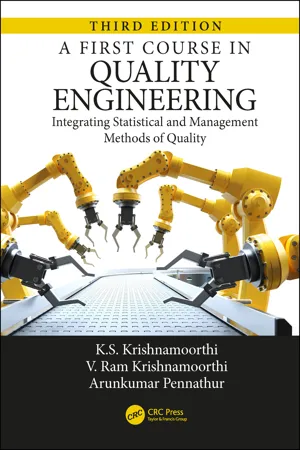
A First Course in Quality Engineering
Integrating Statistical and Management Methods of Quality, Third Edition
- 600 pages
- English
- ePUB (mobile friendly)
- Available on iOS & Android
A First Course in Quality Engineering
Integrating Statistical and Management Methods of Quality, Third Edition
About this book
This book is the leader among the new generation of text books on quality that follow the systems approach to creating quality in products and services; the earlier generations focused solely on parts of the system such as statistical methods, process control, and management philosophy. It follows the premise that the body of knowledge and tools documented by quality professionals and researchers, when employed in designing, creating and delivering the product will lead to product quality, customer satisfaction and reduced waste. The tools employed at the different stages of the product creation cycle are covered in this book using real world examples along with their theoretical bases, strengths and weaknesses.
This textbook can be used for training - from shop floor personnel to college majors in business and engineering to practicing professionals. Graduate students training as researchers in the quality field will also find useful material. The book has been used as the text for a Professional Series Massive Open Online Course offered by the Technical University of Munich on edX.org, through which tens of thousands of participants from all over the world have received training in quality methods. According to Professor Dr. Holly Ott, who chose the book for the course, the text is one of the main factors contributing to success of this MOOC.
The Third Edition has been fully revised to be friendly for self-study, reflects changes in the standards referenced such as ISO 9000, and includes new examples of application of statistical tools in health care industry.
Features:
- Reviews the history of quality movement in the U.S. and abroad
- Discusses Quality Cost analysis and quality's impact on a company's bottom line
- Explains finding customer needs and designing the product using House of Quality
- Covers selection of product parameters using DOE and reliability principles
- Includes control charts to control processes to make the product right-the-first-time
- Describes use of capability indices Cp and Cpk to meet customer needs
- Presents problem solving methodology and tools for continuous improvement
- Offers ISO 9000, Baldrige and Six Sigma as templates for creating a quality system
Frequently asked questions
- Essential is ideal for learners and professionals who enjoy exploring a wide range of subjects. Access the Essential Library with 800,000+ trusted titles and best-sellers across business, personal growth, and the humanities. Includes unlimited reading time and Standard Read Aloud voice.
- Complete: Perfect for advanced learners and researchers needing full, unrestricted access. Unlock 1.4M+ books across hundreds of subjects, including academic and specialized titles. The Complete Plan also includes advanced features like Premium Read Aloud and Research Assistant.
Please note we cannot support devices running on iOS 13 and Android 7 or earlier. Learn more about using the app.
Information
1Introduction to Quality
1.1A Historical Overview
Table of contents
- Cover
- Half Title Page
- Title Page
- Copyright Page
- Contents
- Preface to the Third Edition
- Preface to the Second Edition
- Preface to the First Edition
- Authors
- Chapter 1 Introduction to Quality
- Chapter 2 Statistics for Quality
- Chapter 3 Quality in Design
- Chapter 4 Quality in Production—Process Control I
- Chapter 5 Quality in Production—Process Control II
- Chapter 6 Managing for Quality
- Chapter 7 Quality in Procurement
- Chapter 8 Continuous Improvement of Quality
- Chapter 9 A System for Quality
- Appendix 1Statistical Tables
- Appendix 2Answers to Selected Exercises
- Index